Long-tail keywords are specific phrases people type into search engines that can help you drive more organic traffic to your website.
But how to find and use them?
This guide will help you out.
Contents:
What Are Long-Tail Keywords?
Long-tail keywords are queries that typically consist of three or more words and tend to have a small number of searches per month.
These terms can be laser-focused on a specific topic or product, making them an invaluable tool for boosting your website’s presence online.

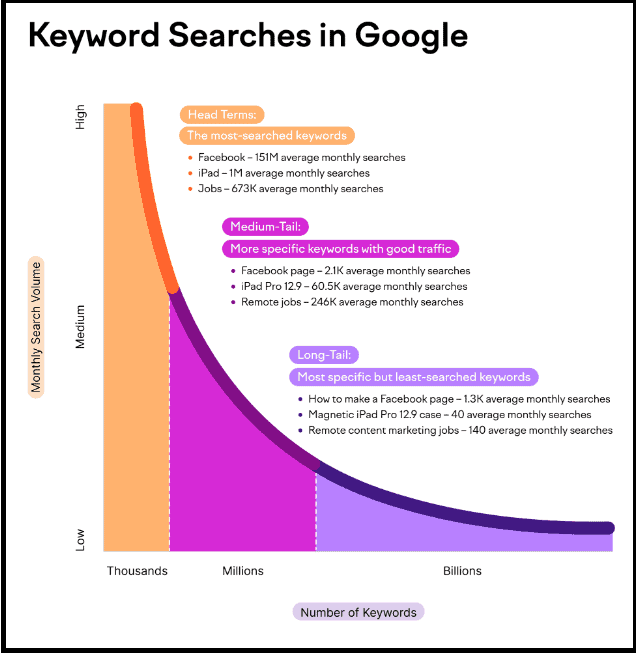
The “head” of the curve is composed of a few terms with extremely high search volumes, while the “tail” contains billions of words that are scarcely searched.
In fact, according to Ahrefs, only 31,000 keywords have a search volume above 100k searches per month.
This SEO statistic shows that, on the contrary, there are 3.8 billion that get less than 10 searches monthly, which is 95% of the entire Ahrefs U.S. keyword database!
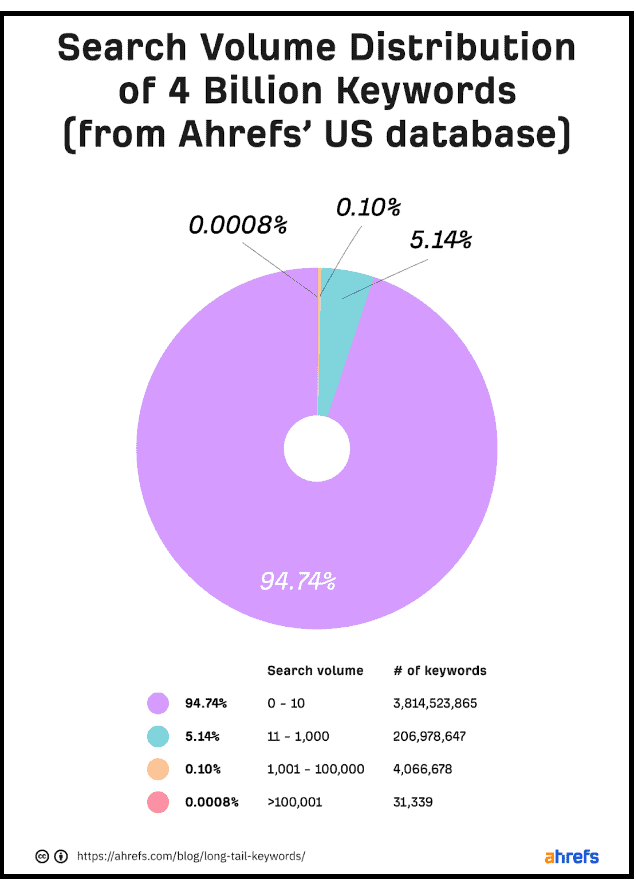
But that’s only the tip of the iceberg.
It’s a well-known fact that 15% of Google search queries are new:
Fun fact: 15% of all Google searches have never been searched before.
— Google (@Google) February 15, 2022
For example, “shoes” might be a popular search term and have millions of searches each month.
On the other hand, long-tail keywords like “women’s leather dress shoes size 8” are much less popular.
This is because these words are often more specific and have less competition, making them easier to rank in search results.
So, what does this mean for you?

Plus, long-tail keywords can help you achieve better rankings on search engine result pages (SERPs), seeing less competition.
Why Are Long-Tail Keywords Important?
They are important because they can help you “drill down” and target more specific users.
For example, instead of targeting “shoes”, you could focus on a long-tail term like “high-top sneakers for men”.
This means you can get in front of users who are looking for exactly that narrowed topic.
In addition, long-tail keywords are often used by people who are further along the sales funnel and thus more likely to convert.
They are also used for voice search queries, which are gaining in popularity.
In fact, Purna Virji (ex-Microsoft) stated:
Voice search keywords are longer, compared to text search keywords (source)
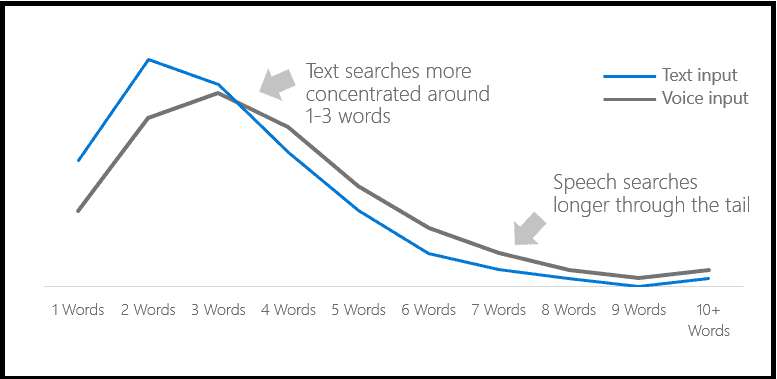
Finally, they can help you rank better on SERPs by reducing competition and targeting more specific terms.
Let’s sum up the key points here:
- Easy to Rank
- Targeted Traffic
- Less Expensive PPC Advertising
Easy to Rank
Take for example the query “copywriting”. It has about 161 million results.
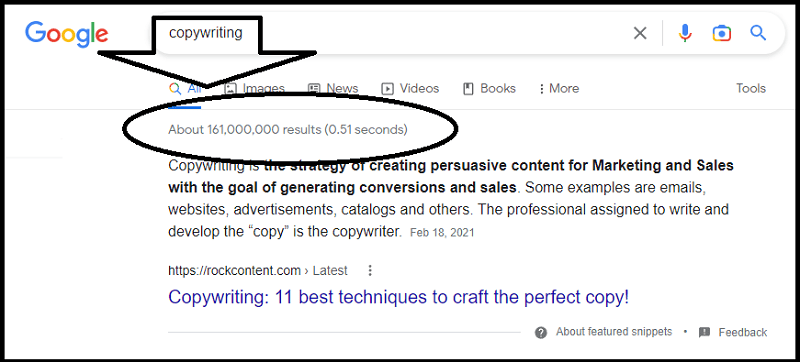
As you can see the competition is huge!
But “bucket brigade copywriting” generates only 500,000 search results:

So, if you target this long-tail keyword, you’ll compete with far fewer websites.

The same difference can be seen if you check the keyword difficulty with your favorite SEO tool.
If you measure it with the Ahrefs free checker, for example, you can see that “copywriting” has a KD of 76:
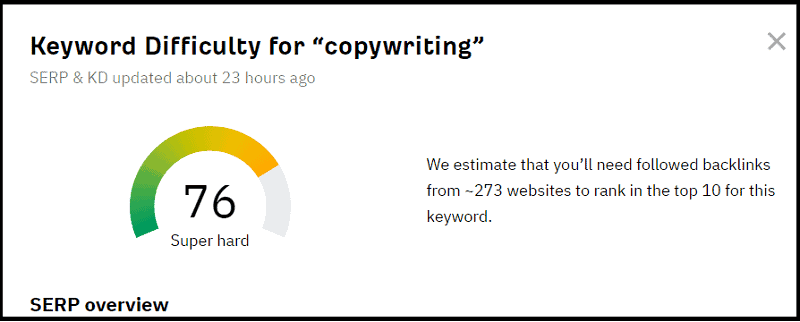
That’s super hard to rank!
On the other hand, the keyword “bucket brigade copywriting” has a DK of only 25:
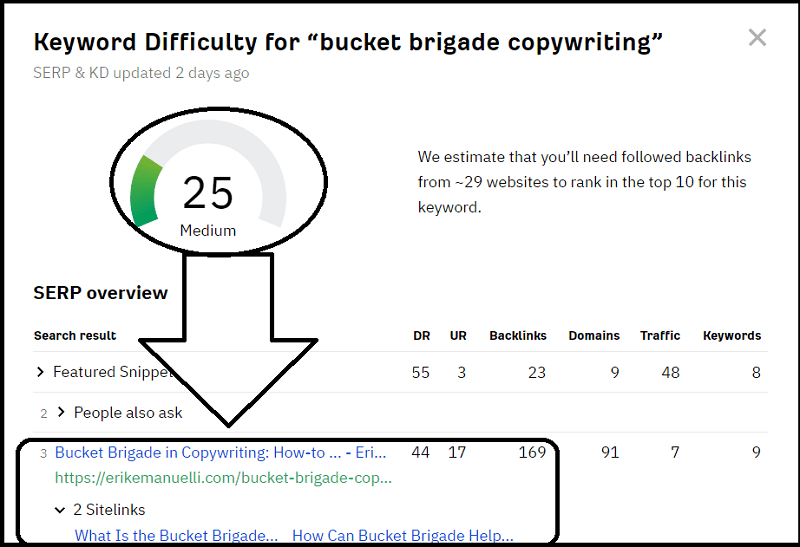
Much easier, as you can see!
In fact, my “Bucket Brigade in Copywriting” article is ranking number three, at the moment, with a rich snippet!
Plus, it is ranking in the top positions for some variants of this keyword, like “bucket brigade words”, “bucket brigades list”, or “bucket brigade examples”.
For some of them, the content has even earned a featured snippet:
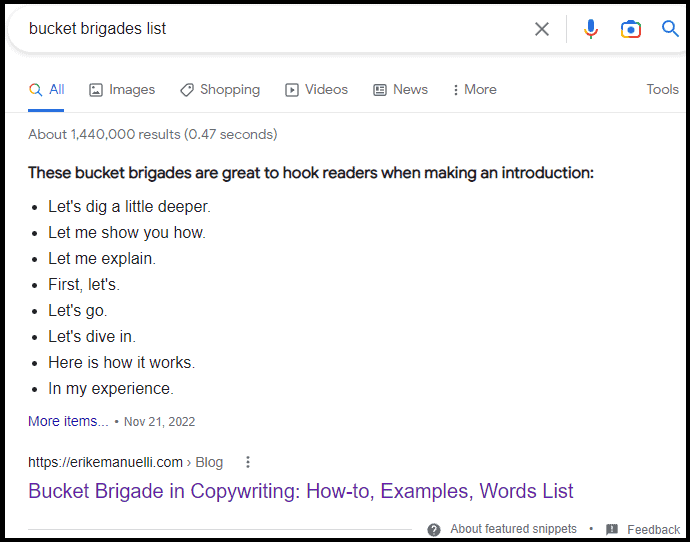
Targeted Traffic
Long-tail keywords can help you target a more specific audience who are already searching for what your business offers.
This means your website or blog can attract the right people at the right time, resulting in more conversions and sales.
And, since these terms are so specific, users are likely to be ready to buy.
Take, for example, the query “blogger outreach software”.
Again, if you measure it with your favorite SEO tool, you can analyze how profitable it can be.
Let’s use the Semrush keyword overview feature this time. You can note that:
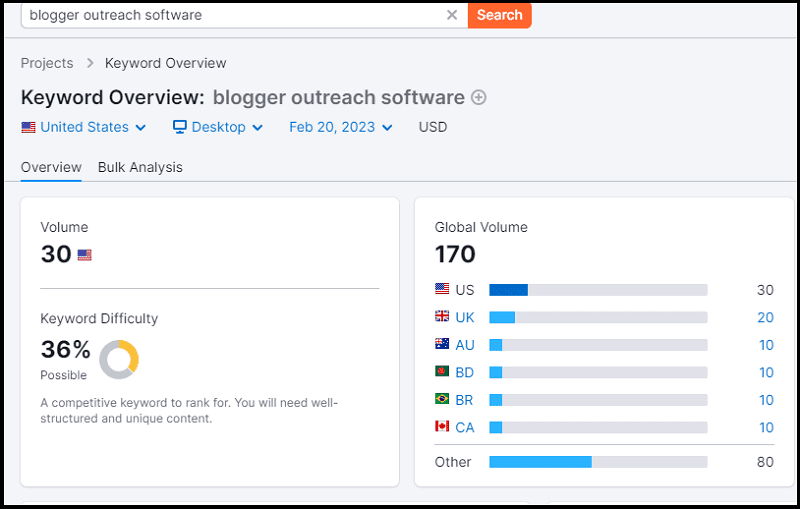
Anybody searching for that term is likely to be near to a purchase decision, even if they are still comparing different software programs.
On the contrary, the keyword “blogger outreach“, is much broader:

And you can notice that these users are likely conducting an initial exploration on the topic of blogger outreach.
It might be a while before they are ready to search for software to assist with their blogger outreach tactics.
Less Expensive PPC Advertising
Finally, long-tail keywords can also help you save money on your PPC advertising campaigns.
Do you want to know how?
Though high-volume terms may yield a higher cost per click, they don’t always bring successful conversions.
That’s why low-volume keywords are often the ultimate targeted choice for those looking to enhance their conversion rate and get more bang for their buck.

The big downside of using these terms is that you must rank on several search results in order to acquire the same amount of traffic as one successful head keyword.
How to Find Long-Tail Keywords
The best way to find them is through keyword research.
You can use different strategies. Here are some of the most effective ones:
- People Also Ask
- Google Search Console
- Quora
- Google Related Searches
- Google Adwords Keyword Planner
- Semrush Keyword Magic Tool
Here are 21 detailed guides.
People Also Ask
Google’s People Also Ask is a popular SERP feature that gives you ideas related to head terms.
It’s located in the middle of the search result (usually just after the first position) and lists questions related to your query:
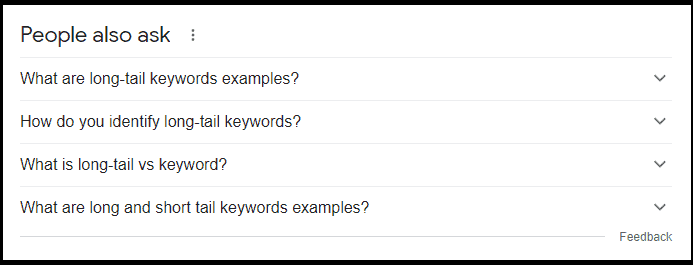
Each of these questions can be used as inspiration for your content creation, SEO, or PPC campaigns.
And if you want to dig deeper, just click on a question, to get more generated below:
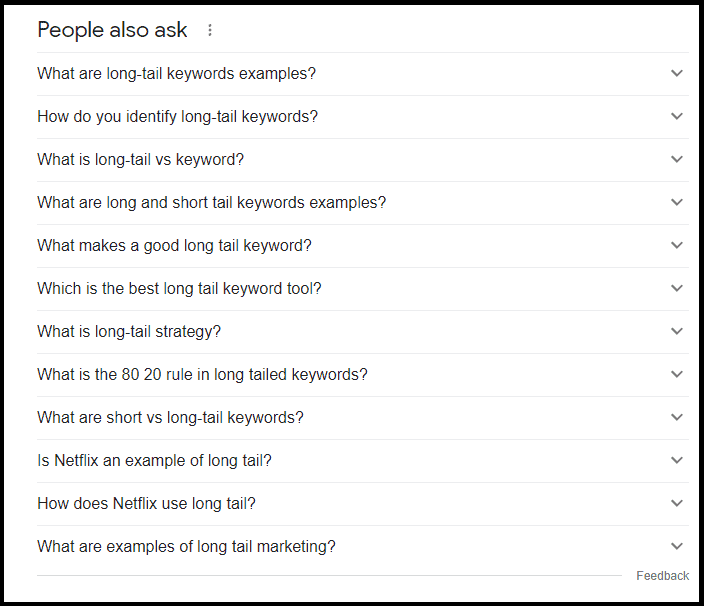
Google Search Console
Google Search Console can provide you with invaluable data about the keywords users are typing to find your content.
You can start by looking at the queries that are bringing people to your website and then searching for long-tail related to them.
This can be done by visiting the “Performance” tab of your GSC:
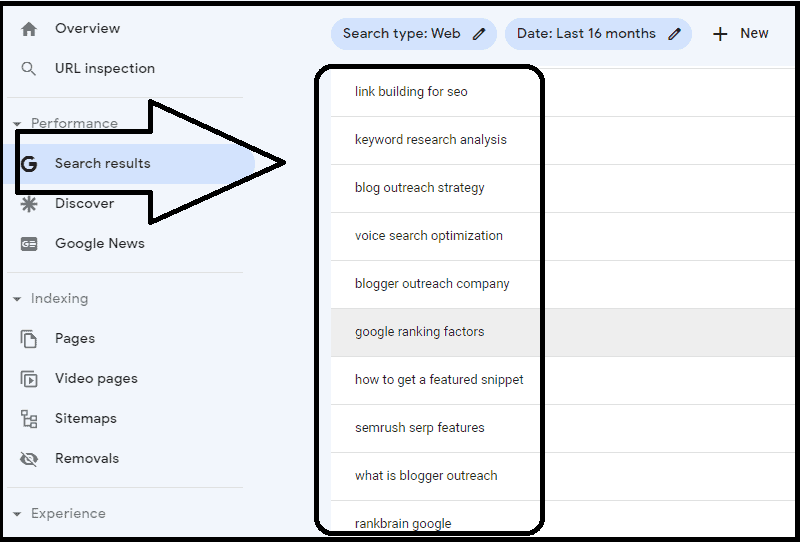

It’s a golden opportunity to check among them and find terms that you can easily rank for higher positions!
Quora
Quora is an excellent source of long-tail words.
Just type in a head term related to your business and you’ll get plenty of keyword suggestions that people are using to search for answers:
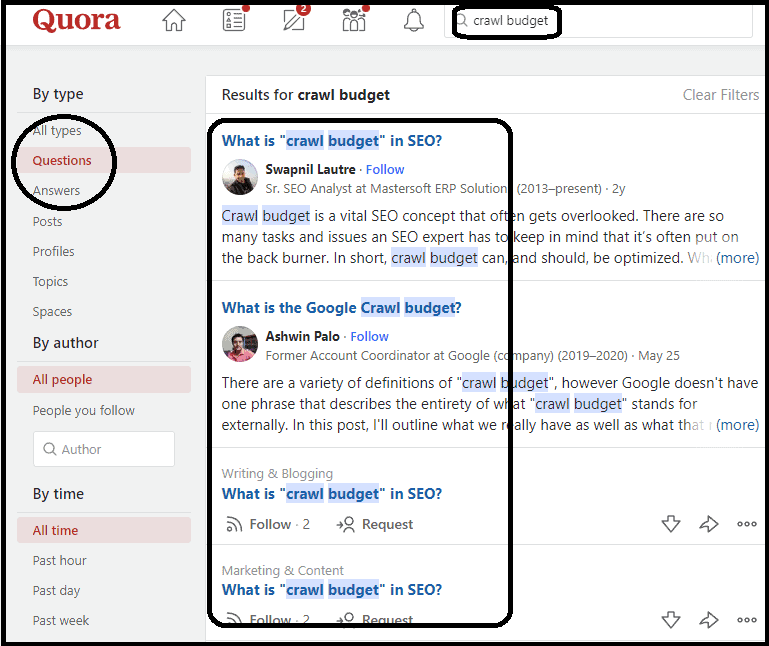
Google Related Searches
Google’s “related searches” feature is located at the bottom of the SERP.
It shows a list of suggestions related to the query you have typed.


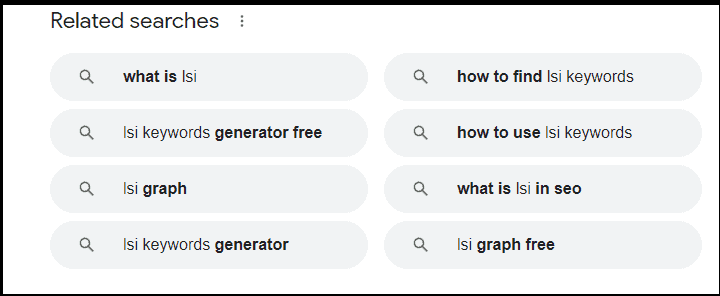
Google Adwords Keyword Planner
Advertisers and marketers use this popular Google tool to plan their keyword strategy.
It allows one to research keywords, view monthly search volumes, and analyze the competitiveness of different phrases.
What you want to do is fetch a topic idea into Adwords Keyword Planner.
For example, if you type “WordPress SEO“:
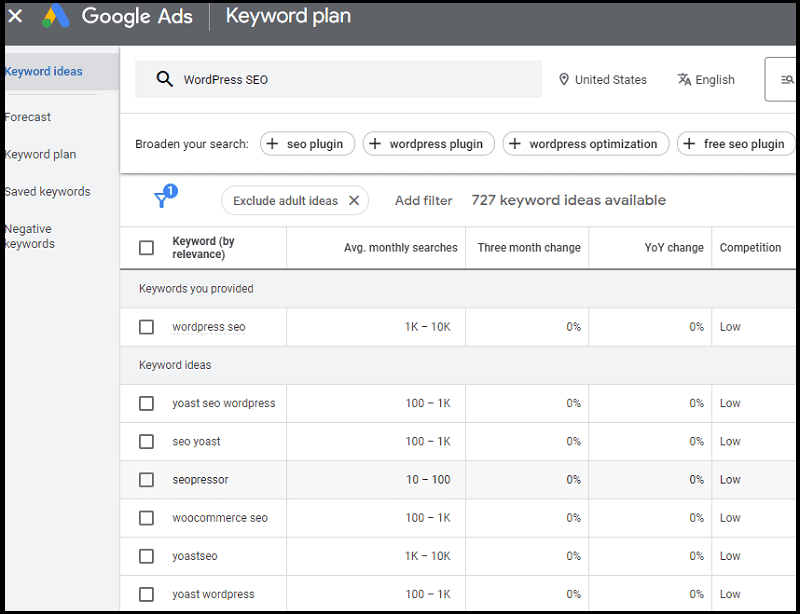
You can see that you will get keyword ideas related to it.
You can then filter out based on competition or average monthly searches, to find long-tail keywords that have a low search volume and low competition.
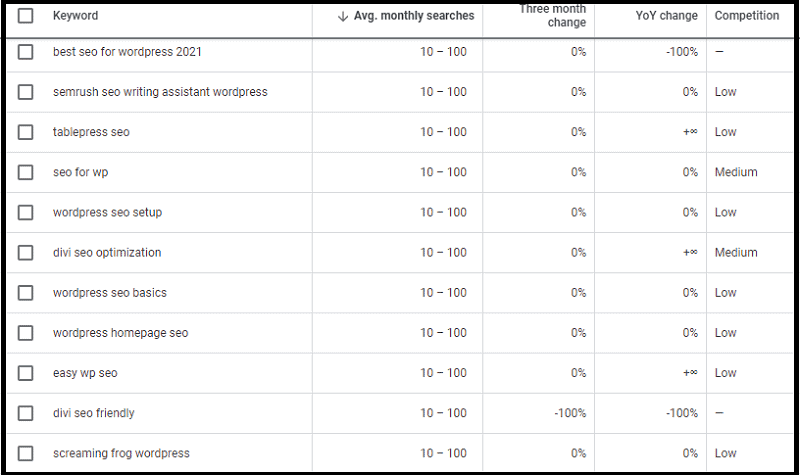
Semrush Keyword Magic Tool
The Semrush keyword magic tool is one of the most powerful long-tail research tools available.
It can help you find hidden gems for your next piece of content.
It also gives you valuable insights about competition, cost per click, and more.
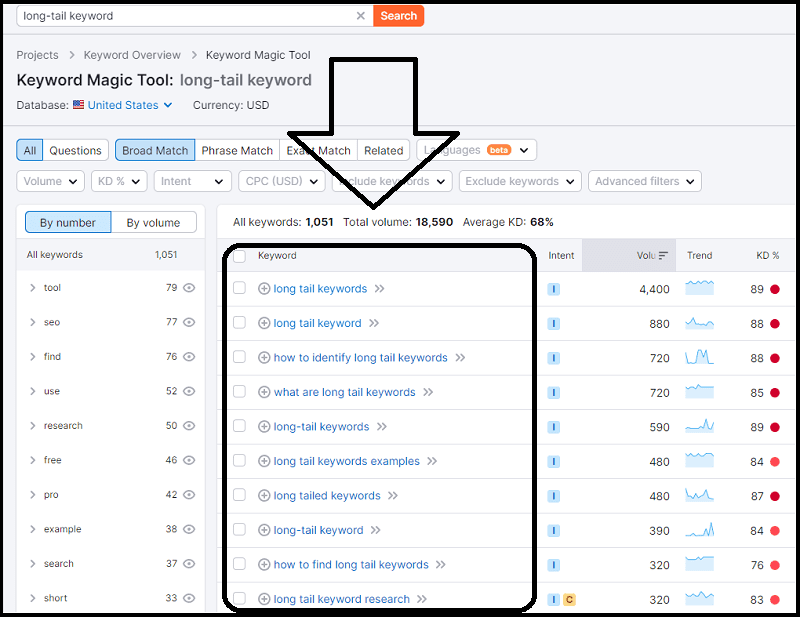
What Makes a Great Long-Tail Keyword?
Generally, it should have low competition and high search volume.
It should also be relevant to your website and provide added value to your target audience.
On top of that, it should be long enough so you can rank for it – usually between 4-7 words long.

- Popularity (Search Volume)
- Keyword Difficulty
- Relevance
Popularity (Search Volume)
In terms of popularity, long-tail keywords should have a good search volume to support the efforts you’ll put into optimizing for them.
No matter how relevant or competitive they are, it won’t do any good if nobody searches for them.
So, what makes a good search volume?
Try to follow this rule.
If you’re searching for keywords with a search volume of:
- Less than 50: Avoid targeting them individually
- 50 to 250: Group related terms together
- More than 250: Use each keyword as its own focus
For example:
- “Search metrics ranking factors” (10): use similar phrases like “SEO ranking Google” or “Google ranking factors“
- “Tips for link building” (150): merge with similar terms like “link-building strategies” or “SEO link strategies”
- “HTTP status codes” (18.000): build an in-depth guide
Keyword Difficulty
The keyword difficulty metric can help you narrow down long-tail keywords and focus your efforts on terms that have a higher chance of ranking well.

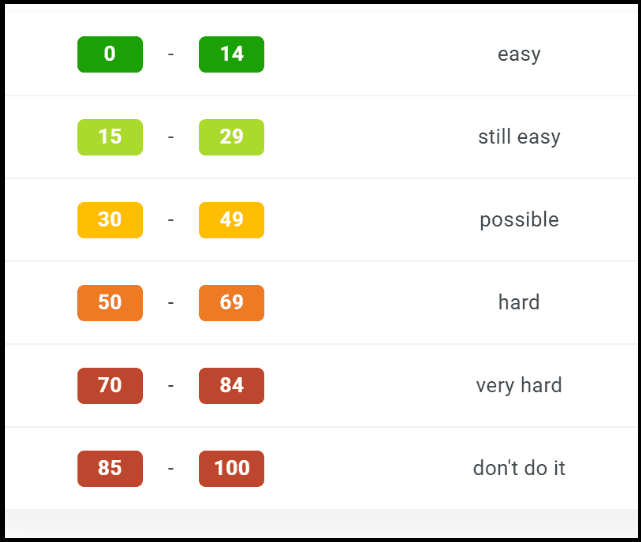
If you want to appear on page one of search engine results pages, then the higher-scoring keywords will require more effort in terms of SEO optimization.
So, what KD should you aim for?
Of course, it depends.
If you’re a new website, try to target keywords with KD scores between 0-30.
For established sites, focus on KD scores of 0-50.
Relevance
As a rule of thumb, your target keywords should be relevant to your content (and business).
You don’t want to try and rank for long-tail terms that are irrelevant to your website’s topic, as it won’t bring in any long-term benefits.

For example, if you are selling pet food, try to rank for more specific queries such as “organic dog food” instead of just “pet food”.
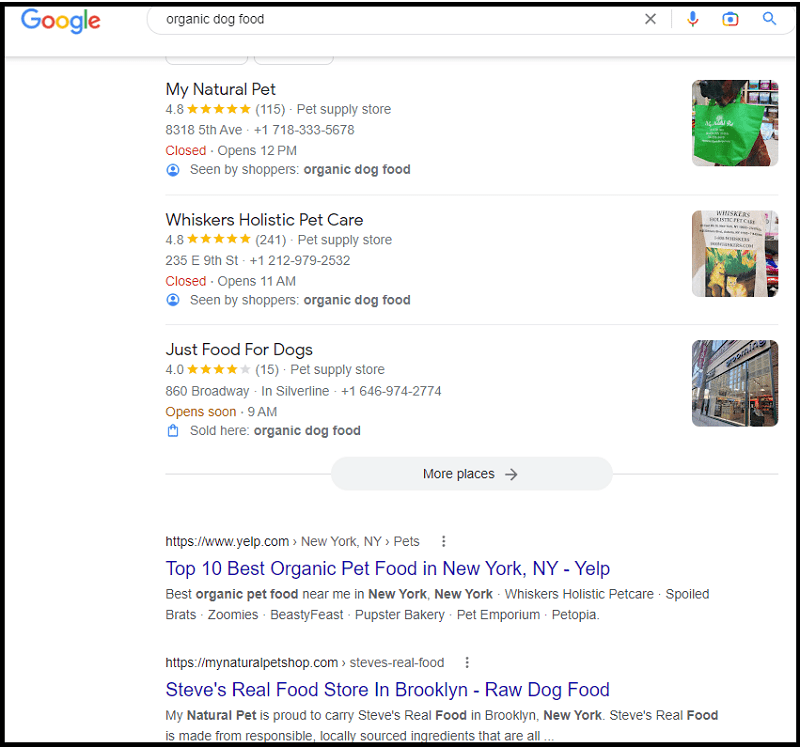
To make your content even more targeted and relevant, use modifiers such as time, location, price range, type of product/service, and more.
How to Use Your Long-Tail Keywords
Once you’ve identified your target, the next step is to create content.
Keep in mind these key points:
On-Page Optimization
To maximize their potential, make sure to include your long-tail keywords in the following content areas:
- Page title
- Meta description
- Header and sub-headers
- Image ALT tags
- Body copy
- URL
These will help search engines identify what your page is about and serve them up in relevant search results.
One important thing to remember is not to overuse this strategy, as it can lead to keyword stuffing, which is a big SEO no-no.
In fact, this is mentioned in the recent update of the Google Search Essentials, in the SPAM policy section.

And make a practical example to help you understand how I was able to rank in the top position in a short time for this long-tail keyword:
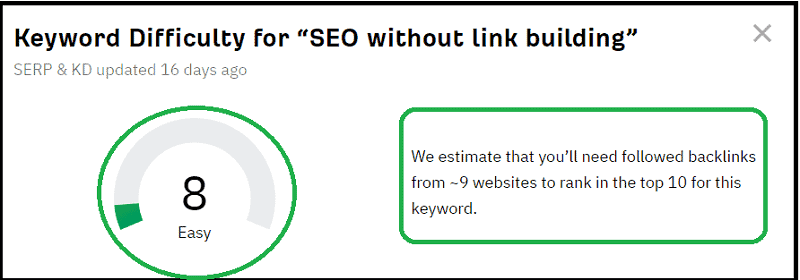
I created this +3000 word guide that covers everything about “SEO without link-building”, including ten ways to rank without backlinks:
- Parasite SEO
- Topical Authority
- Keyword Research
- On-page SEO
- News
- Internal Links
- Organic CTR
- UX signals
- Schema Markup
- Core Web Vitals
So, where did I place the keyword?
In the page title:

In the meta description:

In the sub-headings (when possible, without forcing):
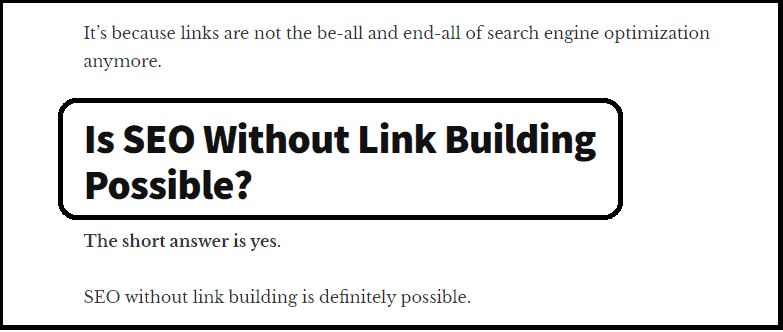
In the image ALT tags (refer to this image SEO guide for further optimization):

Within the body (remember to place your long-tail keywords naturally within the content and not overdo it. The Yoast plugin can help you check the right ratio):
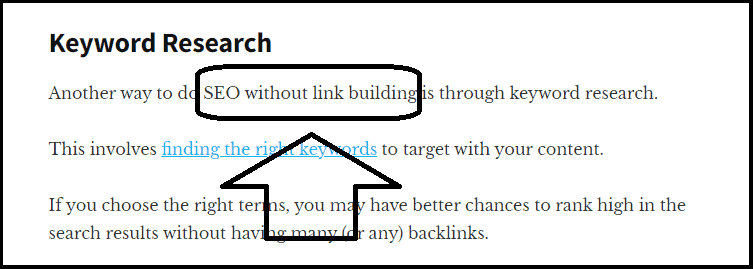
And finally, in the URL of your content:

Creating an outstanding, optimized article around this long-tail keyword helped me reach position zero in Google:
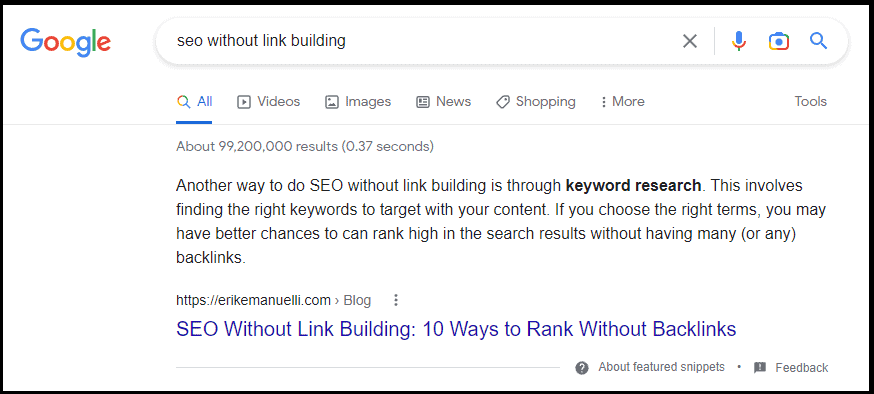
And a feature in the People Also Ask section:
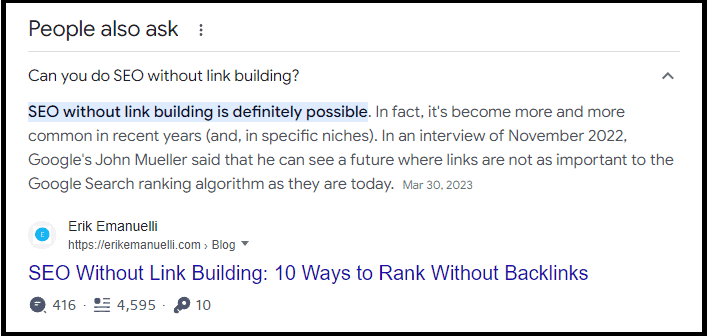
User’s Search Intent
When users type long-tail keywords into search engines, they are looking for something specific.
So, it’s important to consider their intent when crafting your content.
For example, someone searching for “link-building services” is probably farther along in the buyer’s journey than someone who searches for “link-building tips“.
The first user already knows what they are looking for and is likely to be interested in purchasing a service. You should cater your content accordingly by providing detailed information on the services you offer and why they should choose you.
The second user, however, is still in the research phase and wants to learn more about link-building strategies. Your content should focus on providing helpful tips and advice on the topic.

In the case of “link-building services”:
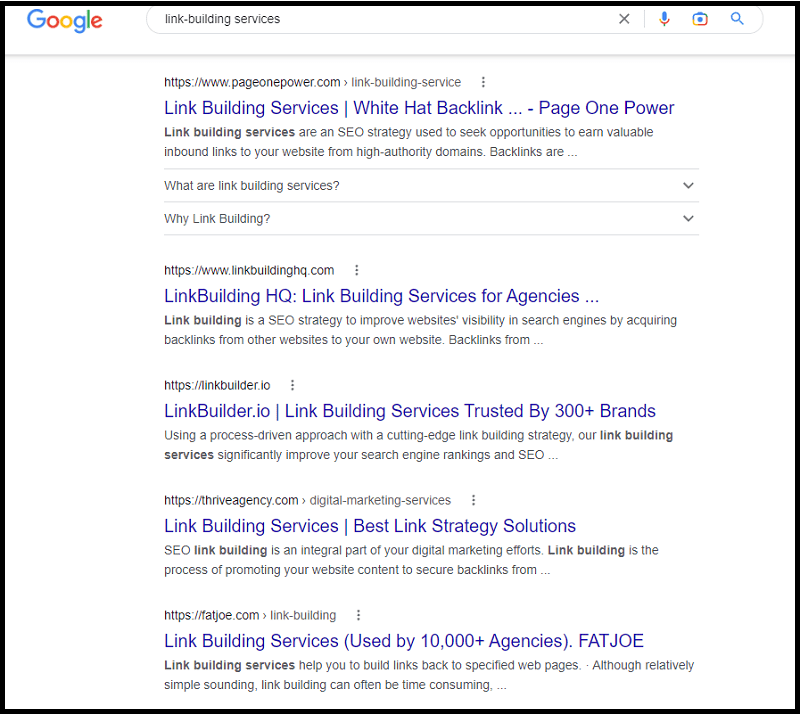
The results on the first page are companies that sell link-building services, so that’s a good indicator of user intent.
In the case of “link-building tips”:
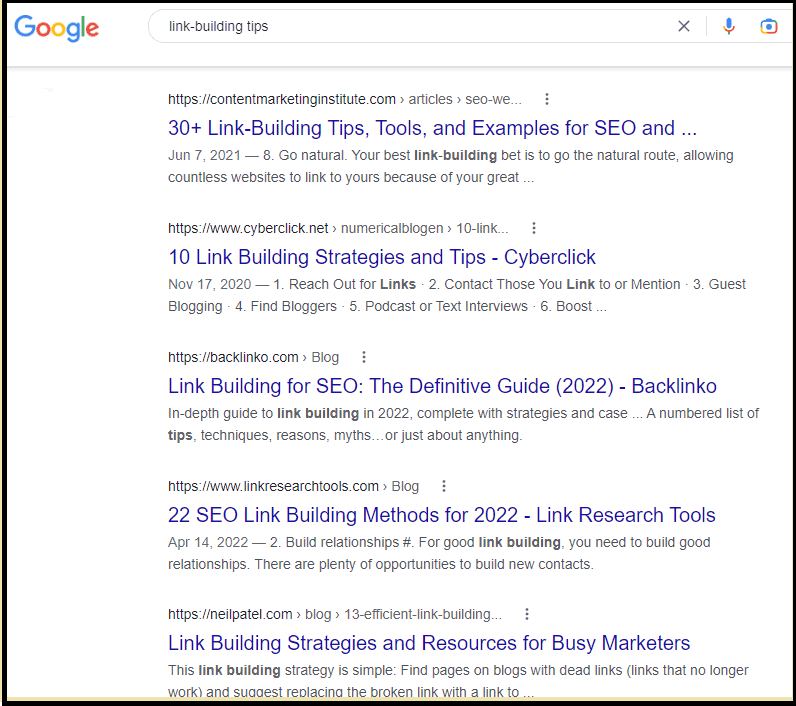
The results on the first page are blog posts, articles, and videos about link-building strategies.
So, if you want to beat the competition, focus on creating long-form content offering helpful tips and guides.
Finally, keep in mind that there are four different search intents:
- Navigational, when a user is looking for a specific website
- Informational, when someone wants to learn more about something
- Transactional, when people are looking to buy something
- Commercial, when the person is looking to compare or purchase products
Keyword Cannibalization Important Reminder
Don’t make the common mistake of creating multiple pages on your site for similar keyword variations with identical user intent.
This was a suitable tactic decades ago, but now it will just cause you to compete against yourself for higher rankings in Google’s SERPs.
To optimize your content and save time, start grouping similar keywords. Doing so will prevent the cannibalization of existing rankings.
Semantic SEO
Semantic SEO helps search engines better understand the context of your content.
It involves using related words and phrases, also known as Latent Semantic Indexing (LSI) keywords.
For example, if you’re writing about SEO copywriting, you might consider using similar words and phrases such as “SEO content writing” or “content marketing”.
Using LSI terms can help boost your rankings and make them more relevant to the search query.

It’s also a great way to optimize for voice search since people often use natural language when speaking to digital assistants.

You should focus on providing comprehensive content that answers all of the user’s related questions. This will help you rank higher in those specific searches as long as you’ve provided quality information that is also relevant to the user’s search query.
To further optimize for semantic SEO, follow these recommendations:
- Optimize For Keyword Clusters
- Answer People Also Ask Questions
- Write Topic Outlines
- Use Related Terms and Synonyms
- Publish Long Content
- Add Structured Data
Before You Go
Thanks for reading so far!
Don’t forget to use LSI terms to make your content more relevant:
By following these guidelines, you can make sure your content strategy generates long-term success.

Long-tail keywords are so important, I know. I don’t use enough of them but will come back to your post and start implementing them more. Very nice in-depth look into this topic, as are all of your posts!
Long-tail keywords help you get relatively easy organic traffic.
The hard part is finding those hidden gems. And I’m sure that most experienced SEOs are hunting them!
Thanks for reading this guide, Sabina.
I hope it could be a reference point to help you create more content around long-tail keywords.
I really appreciate the positive feedback! 🙂
Hi Erik,
Wow, this is one heckuva read! Thanks so much for explaining Semantic SEO and LSI keywords, those are weaknesses of mine I know I need to rectify in my content.
Your deep dives are something to behold, thanks so much.
Dani
I’m glad to hear you really enjoyed the content, Dani.
Thanks for the great feedback.
Interesting point Erik on aiming for 4 words. I have read a few posts on long tail keywords but never saw that specific piece of blogging advice. It makes perfect sense because most bloggers try to grab the low hanging fruit of 1-2 keywords but since competition is high for these heavy volume offerings most waste time fighting over ’em.
I figure it seems to be far simpler to go long tail, nail down a number of longer combinations and to drive passive, steady blog traffic over the long haul.
Excellent post bro.
Ryan
Most of my organic traffic is coming from long-tail queries, Ryan.
They are a great way to get the initial traction on Google that new sites need.
The tricky part is finding those hidden gems. Much easier than creating content around them.
Thanks for visiting and commenting, buddy!
Thanks for the information. I will keep this and work on implementing your ideas.
Hey Gabe,
good to hear you enjoyed the content.